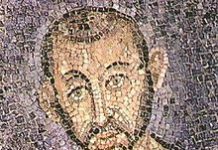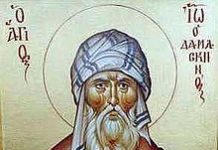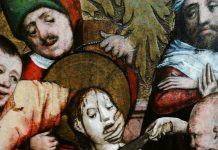‘This is my Son, the Beloved, with whom I am well pleased’ (Mt. 3:17). ⧾
Today’s Feast of the Lord’s Baptism brings to a completion our celebration of the Feast of Christmas and the Epiphany which we celebrated last Sunday. The Epiphany specifically celebrates the manifestation of Christ Our Lord to the nations and today’s Feast likewise celebrates a manifestation of Our Lord as the Son of God, the Beloved. ‘This is my Son, the Beloved, with whom I am well pleased’ (Mt. 3:17). As God, Jesus did not need to receive John’s baptism of repentance but He did so as an example for us for whom baptism marks the beginning of the life of grace, our own divine filiation. St. Maximus of Turin explains: Christ is baptized, not to be made holy by the water, but to make the water holy, and by his cleansing to purify the waters which he had touched…For when the Saviour is washed all water for our baptism is made clean, purified at its source for the dispensing of baptismal grace to the people of future ages. Christ is the first to be baptized, then, so that Christians will follow after him with confidence.
Our Lord’s baptism marks the beginning of His public life, just as our own baptism marks the beginning of our Christian life. His baptism marks the revelation of His Sonship and it is on His part the acceptance and inauguration of His mission as God’s Suffering Servant (Catechism of the Catholic Church, 536). It is in Our Lord’s Passion and Death that the full meaning of this particular mission is revealed. So we begin our liturgical and spiritual journey to celebration of the Paschal Mystery at Easter. Having professed our belief in His divinity in the celebration of the Christmas Mystery, with docility of mind and heart we allow ourselves to be led into the Mystery of the Redemption which Our Lord brings about not only through His ministry of teaching and healing, but above all through His Redemptive Sacrifice. Next Sunday, we will encounter John the Baptist as we did in Advent, and we will hear a declaration which we know well: Here is the Lamb of God who takes away the sin of the world! (Jn. 1:29). It is a declaration that is made at every Mass just before the reception of Holy Communion. Through Baptism we are one with Our Lord in His redemptive work and we serve the work of salvation primarily through our conformity and devotion to the instructive and transformative grace of the sacred liturgy. The Incarnation was consummated on the Cross, and is consummated at Mass in the Lamb of God who takes away the sin of the world. As we commemorate the events and mysteries of Our Lord’s public life in the sacred liturgy, we consciously undertake a transformation in Christ in the awareness that this transformation is gradual and mystical, touching our hearts, minds and emotions. This is how we should understand the term active participation at Mass.
By His baptism our Lord embraces our human condition, and our sharing in His baptism means not only a share in His Sonship, enabling us to call God Father, but also a share in this mystery of self- emptying (kenosis) and of service. Ultimately, we are called to live the very life of God in and through our union of shared existence with the Beloved Son. I have been crucified with Christ; it is no longer I who live but Christ who lives in me; and the life I now live in the flesh I live by faith in the Son of God, who loved me and gave himself for me (Gal. 2:20). What this means practically for us is that we yield to do the work God wants to do in each one of us. This is gradual and mystical and only possible if we allow ourselves to abide in the presence of God in silent, personal prayer. This is also a grace particularly associated with silent Eucharistic Adoration. We may term this the passive element of our relationship with God. Simply, this means that Our Lord wants to share His life with us. At the Jordan, Jesus the Word (Logos) of God from all eternity is revealed as the Beloved (Agapitos). By the grace of adoption and by faith, the same is said of us as we are born again and re-created in the waters of baptism. Both Our Lord’s baptism and our own may be understood in light of these words from the second psalm: He said to me, ‘You are my son, today I have begotten you Ask of me, and I will make the nations your heritage and the ends of the earth your possession’.
The mystery of the Church is the fulfillment of this promise through the works of mercy and service, both spiritual and corporal. This is the active element of our relationship with God. When our spiritual union with Our Lord is intense and meaningful, the fruits of this union are evident in a sober life of prayer and in active charity. However, the way of Christian discipleship which we have undertaken to follow, mysteriously, is also a share in the mission of the Son of God, the Lamb of God who came to take away the sins of the world. The union of our suffering with the Atoning Sacrifice of Our Lord is a source of grace and of reparation; and this union is at once both active and passive. This enables us to find meaning and purpose in make sense out of suffering and like Our Lady who was intimately united with Our Lord in the work of salvation, to be drawn into the saving work of Christ through faith and obedience. When we come to understand this truth we see how every prayer, every sacrifice, every act of penance, every act of charity is at the service of the saving Mystery of Christ and nothing is without value or meaning. May God grant us the grace of gratitude for the gift of the true faith and the grace of final perseverance. ⧾











